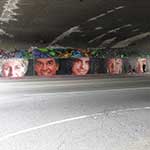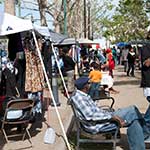There are 68,000 streets in Los Angeles; explore the average pavement quality rankings for neighborhoods in Southern California (information courtesy of L.A. Times).
The City of Los Angles was once named the mural city of the world. After a citywide ban on murals was lifted, murals in the city make a return.
Leimert Park is the African American cultural center of Los Angeles. Residents and community leaders are reviving the neighborhood and are petition the city to make 43rd and Degnan a people street.
People, both male and female, can pay for an escort-like service called Doumee in Koreatown. Doumees can earn well over $1,000 in one night, by partying or spending quality time in Koreatown’s bars, karaokes and cafes.
In Los Angeles, Cailin Stinson, a 23-year-old Office Max employee, usually skateboards her way to and from work. However, she always stops to carry her board before she hits a certain section of Venice Blvd., the block from Fairfax Ave. to Cadillac Ave. "It's not safe to ride my board with all these cracks in the sidewalk," said Stinson. "I'd rather walk this block than face plant."
Los Angeles is known for its celebrities, traffic, weather and beaches. However, what most people don’t know, is that Los Angeles has shattered sidewalks on every block, with roots that uplift sections of sidewalks above the ground by more than one-foot.
Koreatown, P.I.C.O., West Adams, Crenshaw and every other neighborhood in Los Angeles County has one thing in common: severely damaged sidewalks and roads.
More than half of Los Angeles’ roads are severely damaged. With one-foot deep potholes and giant cracks, Los Angeles’ roads are just as bad as its sidewalks.
In fact a recent report done by a national transportation research group called TRIP says that these road conditions cause drivers to have to spend an average of $850 a year on wear and tear and repairs. The organization went even further and gave Los Angeles the award for worst roads in the country.
For years, the city of Los Angeles has struggled to keep up with the maintenance of its sidewalks and roads, but this year, City Hall policy advisors proposed a half-cent sales tax increase to raise $4.5 billion over the next 15 years to repair the majority of these damaged paths.
“This proposal came as an idea to rebuild the streets as they used to be and return the city of Los Angeles to its glory days,” Eric Bruins, the planning and policy director for the Los Angeles County Bicycle Coalition, one of the many organizations working with the city to push for the passage of the proposal, said smiling. “So a coalition of transportation, environmental and equity came together and basically [thought], ‘Why are [we] rebuilding streets from the past and not building streets for the future?’”
More than 28,000 miles of roadways need major repairs in Los Angeles County.
Lawyers who have sued the city – on behalf of pedestrians who claim they were injured because of the crumbling sidewalks – say one key factor is the types of trees the city has planted.
“The sidewalks have been a problem for a long time. I mean with the ficus trees that they planted years ago to try to put shade up … the city didn’t realize that the roots of those trees would lift up the sidewalk slabs; that you’d have these dangerous conditions all over,” said Peter Goldstein, a personal injury lawyer in Los Angeles and Las Vegas, as he pointed to a section of a sidewalk right outside of his office that was in a similar condition.
Tree root growth significantly damages roads and sidewalks. On some streets, slabs of cement are no longer aligned; on others, whole sections of sidewalks are lifted off of the ground.
“A lot of people have sued because people on wheelchairs are not able to use the city’s sidewalks, which has become a serious problem,” said Goldstein with grimace.
Recently, wheelchair users have filed a disabilities lawsuit against the city because of their inaccessibility. Liability issues have become a big problem for several cities, including Los Angeles, that have been sued for violating the Americans with Disabilities Act by not fixing their severely damaged sidewalks. Many disabled citizens claim that many of Los Angeles’ crackling sidewalks breach their rights to public access. If Los Angeles’ proposal to raise sales tax to fix damaged roads and sidewalks were to pass in the November ballot, it could help city officials avoid the potentially costly lawsuit.
In Los Angeles County, the majority of claims the Los Angeles City Attorney’s office receives are trip and fall cases.
“The city spends I believe just under $10 million a year just on trip and fall lawsuits for pedestrians getting injured from these damaged sidewalks, [and] the bill for motorists and bicyclist is probably higher than that,” said Bruins.
Goldstein believes the city is paying much more.
“That [amount] doesn’t include all the time that the city attorney spends defending the cases … so we’re talking about millions of dollars outside of the payouts because of the attorneys fees,” said Goldstein.
Though the majority of people who have hurt themselves due to severely damaged sidewalks or roads do not make a claim against the city, those that do often have fairly serious injuries.
“I’ve had [trip and fall] cases where you’ve had fractured tibias and things like that; that’s the extent of the injuries that I’ve seen, but there are more serious cases,” said Goldstein.
Trip and fall accidents are a regular occurrence, as are road accidents involving bicycles and cars.
“People definitely do, when they’re biking, hit cracks on the roads, potholes, what have you, and when you pop a tire and don’t have your bike under control you can crash,” said Bruins. “Sometimes the bike lanes are as wide as the potholes!”
Los Angeles rarely approves claims seeking monetary compensation for damages caused by potholes; the city only approves about 10 percent of the claims it receives.
However, many auto body repair shops believe that this tactic needs to change, especially since more and more cars are beginning to have lower profile tires. Low-profile tires are tires with a short sidewall height, which is the amount of rubber between the outside edge of the wheel and the road.
Josephine Morante, a certified drug tester, is a Lancaster resident who often travels to Los Angeles for work. Just last year, she found herself in this very situation.
“I used to drive a really old Mini Cooper, and a while back, while driving in Koreatown, I had hit a huge pothole, which really banged up my car since my car is really small and low to the ground. The auto body shop ended up declaring it was totaled because the damages were more than what my car was worth. Luckily I wasn’t hurt, but I was scared to drive for a really long time after that,” said Morante.
Morante had ended up hitting a 1 1/2-foot-deep pothole going 10 mph over the speed limit.
Even though she had the right to make a claim against the city, Morante chose against it. Not only because she figured her claim would be rejected, but because of the time commitment she would have to make to pursue her case.
“I live here in Lancaster, so commuting to and from L.A. for a dispute would just take up time I don’t have. I also can’t afford a lawyer, especially when I can’t be sure if we’d even win,” said Morante, irately.
Ever since the accident, Morante has found it hard to commute to and from her house and work, especially since her work requires her to travel.
“Right now I don’t have a car so I have to use public transportation or have a friend drive me around. It kind of sucks, but I just have to bear with it for now,” said Morante.
Morante’s accident, along with many others, has shown the city that a change needs to occur.
Last month, Mayor Eric Garcetti collected polling data on voters’ support for the proposal. Though the majority of residents want their roads and sidewalks fixed, the poll shows that there seems to be a lot of concerns about the potential revenue source.
“I think the city of Los Angeles should definitely fix up their roads and sidewalks. Obviously they have become a problem for a lot of people, including myself,” said Morante, angrily. “However, I don’t think they should raise sales tax to do so.”
Many Los Angeles residents and visitors do not seem thrilled about having to pay extra sales tax.
“I don’t think raising sales tax is the way to go. That's penalizing, making everybody pay for roads when not everybody is driving on the roads so I think there’s a more equitable way to take care of the expense,” said Hank Warner, a Los Angeles city architect.
Though this rise in sales tax may not be what will appear in November’s ballot, Los Angeles officials are fairly certain on how they plan to repair disintegrated streets.
“Well what’s being talked about right now is taking every street that has a D or F ranking, which basically means the pavement has failed so not only are there potholes, but the sub-base of the street has failed and it needs to be totally reconstructed,” said Bruins.
Los Angeles grades the quality of its streets on an A to F system, A being the best possible quality and F being the worst. More than one-third of the city’s streets have street quality rankings of D’s or worse.
Amelia Moorhead, a 75-year-old woman, takes daily strolls with her husband in their home city of Chula Vista. However, whenever she visits her daughter, who lives on Crenshaw Blvd., she is often too afraid to leave her daughter's house without someone accompanying her, fearing that she might fall on one of Los Angeles' broken sidewalks.
“In Chula Vista, or at least where I live, the sidewalks are smooth and well-kept,” said Moorhead. “Here however, I feel like I could fall any minute … and I’m just too old to have to deal with any injuries.”
“In the past, the city did not have enough money to repair the damaged roads and sidewalks because they were so bad, so the city just let the sidewalks degrade,” said Bruins.
It’s a lot cheaper to maintain a street or road at an A or B than to completely reconstruct it at a C or D, so if the city votes in favor of its proposal to raise sales tax to fix damaged roads and sidewalks, officials plan to work on the highest used roads and sidewalks first and continue to maintain them.
“People should expect their streets and sidewalks safe, and if we have to pay a little bit more money for that to happen then we should,” said Goldstein.
The city of Los Angeles is still considering its options for what it will propose on November’s ballot, especially since officials do not know the exact number of miles of roads and sidewalks that could be repaired with the revenue they collect from their current sales tax plan. However, as of right now, they are sticking to their rise in sales tax idea, and will need the approval of 2/3 of voters to pass.








